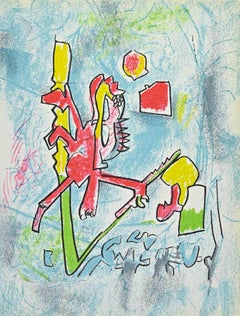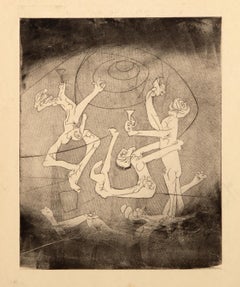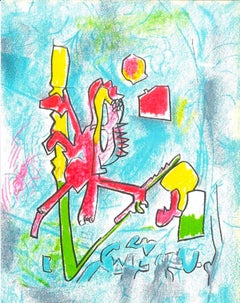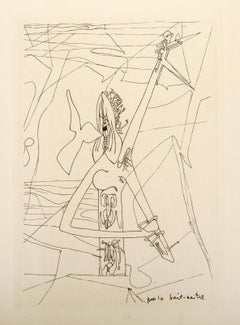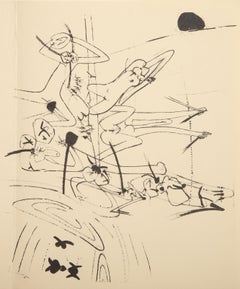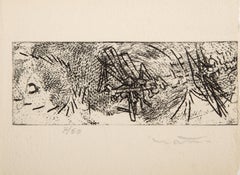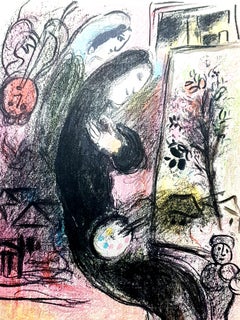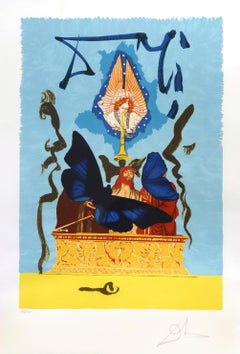Roberto Matta More Prints
“The function of art,” the Surrealist Roberto Matta once stated, “is to unveil the enormous economic, cultural and emotional forces that materially interact in our lives and that constitute the real space in which we live.” In his paintings, Matta sought to expose those forces through the Surrealist practice of automatism, creating work in a free-associative state intended to conjure the unconscious.
After studying architecture in his native Chile, Matta, then 22, chose to pursue the field in Paris, where he mingled with stars of the avant-garde like Gertrude Stein, Salvador Dalí and Walter Gropius. In the late 1930s, he abandoned Paris, together with his job at Le Corbusier’s studio and (for a time) his career, for modern art’s new epicenter, New York City. There, he became a colleague of art legends like Marcel Duchamp and Arshile Gorky.
Although celebrated primarily for his work as a painter, Matta was an equally talented furniture designer. His furniture pieces, like his artworks, are the stuff of dreams. The back of his totem chair, for example, is composed of smiling, cartoonish creatures stacked on top of each other. In his MAgriTTA armchair, the top half of a plush green apple sticks out of large black bowler in homage to its namesake, the Belgian Surrealist René Magritte.
But perhaps the piece that most truly embodies his artistic philosophy is his 1966 Mallite modular system: a collection of spongy, undulating sofas and lounges that can be fitted together to form a puzzle-like room divider. The work, an original edition of which is in MoMA’s permanent collection, has in recent decades been a hard-to-find collectors’ item — until 2019, when Italian design brand Paradisoterrestre issued a reedition, available through Duplex.
Browse Roberto Matta's paintings and furniture designs on 1stDibs.
1970s Surrealist Roberto Matta More Prints
Lithograph
1940s Surrealist Roberto Matta More Prints
Etching
1970s Surrealist Roberto Matta More Prints
Lithograph
1940s Surrealist Roberto Matta More Prints
Etching
1950s Surrealist Roberto Matta More Prints
Lithograph
1960s Surrealist Roberto Matta More Prints
Etching
1970s Surrealist Roberto Matta More Prints
Lithograph
1970s Contemporary Roberto Matta More Prints
Etching
1940s Surrealist Roberto Matta More Prints
Etching
1970s Surrealist Roberto Matta More Prints
Lithograph
1970s Surrealist Roberto Matta More Prints
Lithograph
1960s Surrealist Roberto Matta More Prints
Lithograph
20th Century Surrealist Roberto Matta More Prints
Lithograph
1970s Surrealist Roberto Matta More Prints
Lithograph
1970s Surrealist Roberto Matta More Prints
Lithograph
1970s Surrealist Roberto Matta More Prints
Lithograph
1970s Surrealist Roberto Matta More Prints
Etching
1970s Surrealist Roberto Matta More Prints
Lithograph
1960s Surrealist Roberto Matta More Prints
Etching
1960s Surrealist Roberto Matta More Prints
Etching
1970s Surrealist Roberto Matta More Prints
Lithograph
1960s Surrealist Roberto Matta More Prints
Lithograph
1970s Surrealist Roberto Matta More Prints
Lithograph
20th Century Roberto Matta More Prints
Paper
1980s Surrealist Roberto Matta More Prints
Etching
1960s Surrealist Roberto Matta More Prints
Etching
1960s Surrealist Roberto Matta More Prints
Etching
1940s Surrealist Roberto Matta More Prints
Etching
1960s Surrealist Roberto Matta More Prints
Etching
20th Century Roberto Matta More Prints
Lithograph
20th Century Roberto Matta More Prints
Paper, Etching
1970s Surrealist Roberto Matta More Prints
Lithograph
1970s Surrealist Roberto Matta More Prints
Lithograph
1990s Surrealist Roberto Matta More Prints
Screen
1970s Surrealist Roberto Matta More Prints
Etching
Roberto Matta more prints for sale on 1stDibs.
Artists Similar to Roberto Matta
- 1stDibs ExpertApril 5, 2022Roberto Matta is a painter who became a noted part of the Surrealist movement. Born Roberto Antonio Sebastian Matta Echaurren in 1922 in Santiago, Chile, the artist began his professional life as an architect and slowly switched to painting. His work often featured complex biomorphic forms in disturbing settings, making him an important influence in the post World War II era. Shop a selection of Roberto Matta pieces from some of the world’s top art dealers on 1stDibs.
- 1stDibs ExpertApril 5, 2022Chilean-born Roberto Matta is a modern art painter primarily known for his work in blending surrealism with abstract expressionism. You can shop a selection of expertly vetted Fairfield Porter pieces from some of the world’s top art dealers on 1stDibs.
